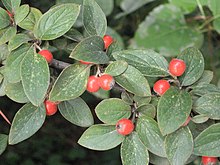Franchet's Cotoneaster
| Franchet's Cotoneaster | ||||||||||||
|---|---|---|---|---|---|---|---|---|---|---|---|---|

illustration |
||||||||||||
| Systematics | ||||||||||||
|
||||||||||||
| Scientific name | ||||||||||||
| Cotoneaster franchetii | ||||||||||||
| Bois |
Franchets cotoneaster ( Cotoneaster franchetii ) is an approximately 2 meter high shrub with orange-red fruits from the pome fruit family (Pyrinae). The natural range of the species is in China, Myanmar and Thailand, in Africa, America, Australia and Europe it is feral. It is often used as an ornamental plant.
description
Franchets cotoneaster is an evergreen or wintergreen, 1 to 3 meter high shrub with overhanging, dark gray-brown or black-gray, initially densely hairy and later balding branches. The leaves are divided into a petiole and a leaf blade. The petiole is 2 to 4 millimeters long and tomentose. The stipules are linear-lanceolate, 2 to 4 millimeters long, initially hairy tomentose and later balding. The leaf blade is simple, oval to ovate, 2 to 3 inches long and 1 to 1.5 inches wide, with a pointed or tapered tip and a wedge-shaped base. The upper side of the leaf is matt, shiny and finely wrinkled, initially hairy and later balding with deeply sunken leaf veins ; the underside is densely hairy yellow to silvery tomentose with protruding leaf veins.
The flowers grow in 1.5 to 2.5 centimeters measured by Schirmrispen from 5 to 11 flowers with felted dense hairy inflorescence stem. The bracts are linear, 2 to 3.5 millimeters long and tomentose. The flower stalks are also hairy tomentose and 2 to 4 millimeters long. The flowers are 6 to 7 millimeters in diameter. The flower cup is bell-shaped and has dense downy hair on the outside. The sepals are triangular, pointed or pointed, 1 to 2 millimeters long and 1.5 to 2.5 millimeters wide. The petals are erect, pink, broadly obovate or oval, 3 to 4 millimeters long and 2 to 3 millimeters wide, with a blunt tip and a short nailed base. The top is finely haired at the base. The 20 stamens are shorter than the petals. The tip of the ovary is hairy downy. The two or three sometimes up to five free-standing styles are shorter than the stamens. The fruits are 6 to 7 millimeters in diameter. They are orange-red or red, ovate-round, initially hairy and later balding. Usually three, rarely up to five seeds are formed per fruit. Franchet's cotoneaster flowers in June and July, the fruits ripen from September to October.
The number of chromosomes is 2n = 68.
Occurrence and location requirements
The natural range is in the Chinese provinces of Guizhou , Sichuan , Xizang and Yunnan , in Myanmar and Thailand . It has become feral in South Africa , Australia and New Zealand, Europe and California . Franchet's cotoneaster grows in steppes and dry forests at an altitude of 1,600 to 2,900 meters on moderately dry to fresh, slightly acidic to alkaline, sandy-loamy to loamy, nutrient-rich soils in light to partially shaded locations. The species loves warmth and is moderately frost hardy .
Systematics
Cotoneaster franchetii ( Cotoneaster franchetii ) is a kind of the genus of cotoneaster ( Cotoneaster ). It is in the family of the rose family (Rosaceae) of the subfamily spiraeoideae, tribes of the subtribe Pyreae maloideae assigned (Pyrinae). The species was first described scientifically in 1902 by Désiré Georges Jean Marie Bois . The generic name Cotoneaster is derived from the Latin "cotoneum malum" for the quince ( Cydonia oblonga ). The ending "aster" is a coarse form for groups of plants that are considered inferior in comparison to similar groups. The specific epithet franchetii refers to the French botanist Adrien René Franchet .
use
Franchet's cotoneaster is often used as an ornamental wood because of its remarkable fruits and striking autumn color .
proof
literature
- Wu Zhengyi, Peter H. Raven, Deyuan Hong (Eds.): Flora of China . Volume 9: Pittosporaceae through Connaraceae . Science Press / Missouri Botanical Garden Press, Beijing / St. Louis 2003, ISBN 1-930723-14-8 , pp. 96 (English).
- Andreas Roloff , Andreas Bärtels: Flora of the woods. Purpose, properties and use. With a winter key from Bernd Schulz. 3rd, corrected edition. Eugen Ulmer, Stuttgart (Hohenheim) 2008, ISBN 978-3-8001-5614-6 , p. 230.
- Jost Fitschen: Woody flora . 12th, revised and expanded edition. Quelle & Meyer, Wiebelsheim 2007, ISBN 3-494-01422-1 , p. 439 .
- Helmut Genaust: Etymological dictionary of botanical plant names. 3rd, completely revised and expanded edition. Nikol, Hamburg 2005, ISBN 3-937872-16-7 (reprint from 1996).
Individual evidence
- ^ German name according to Roloff et al .: Flora der Gehölze , p. 230 and after Fitschen: Gehölzflora , p. 439
- ↑ a b c d Zhi-Yun Zhang, Hongda Zhang, Peter K. Endress: Cotoneaster franchetii , in: Wu Zhengyi, Peter H. Raven, Deyuan Hong (eds.): Flora of China . Volume 9: Pittosporaceae through Connaraceae . Science Press / Missouri Botanical Garden Press, Beijing / St. Louis 2003, ISBN 1-930723-14-8 , pp. 96 (English).
- ↑ a b c d Roloff et al .: Flora der Gehölze , p. 230
- ↑ a b Cotoneaster franchetii. In: Germplasm Resources Information Network (GRIN). United States Department of Agriculture, accessed April 29, 2012 .
- ↑ D. Potter, T. Eriksson, RC Evans, S. Oh, JEE Smedmark, DR Morgan, M. Kerr, KR Robertson, M. Arsenault, TA Dickinson, CS Campbell: Phylogeny and classification of Rosaceae . Plant Systematics and Evolution, Volume 266, 2007, pp. 5-43. doi : 10.1007 / s00606-007-0539-9
- ↑ Exactly: Etymological Dictionary of Botanical Plant Names , p. 181
Web links
- Thomas Meyer: Data sheet with identification key and photos at Flora-de: Flora von Deutschland (old name of the website: Flowers in Swabia )
- Cotoneaster franchetii. In: The Plant List. Retrieved April 29, 2012 .
